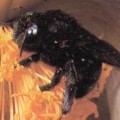Family Structure
- Form colonies which are ruled by small groups of queens or single queens
- Even if only one queen survives, a colony can expand to thousands within a month or so
- There may be multiple queens in some colonies
Habitat
- Large mounds in open area
- Mounds can reach heights of 40 cm (15.7 in)
- Mounds can also be as deep as five feet
- Nest in moist soil, near river banks and ponds, lawns and freeway medians
- Nest not visible; built under landscaping timbers, rocks and similar objects
- Dome-shaped mounds will be constructed if no cover; usually found in open spaces e.g. fields, parks and lawns
Diet
- Young plants, seeds, and sometimes crickets
- Often attack small animals; can even kill them
- Bite only to get a grip; then sting (from the abdomen)
- Inject a toxic alkaloid venom called solenopsin which produces a painful sting, similar to what one feels when burned by fire—hence the name “fire ant”
- Venom can be deadly to some individuals
Contact Us
Contact us for help with a Fire Ant problem. You may also call either our Central Coast office or our Ventura County office.






